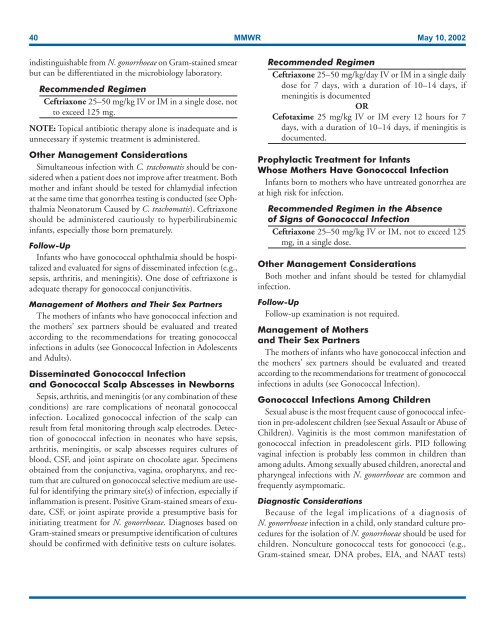You also want an ePaper? Increase the reach of your titles
YUMPU automatically turns print PDFs into web optimized ePapers that Google loves.
40 MMWR May 10, 2002<br />
indistinguishable from N. gonorrhoeae on Gram-stained smear<br />
but can be differentiated in the microbiology laboratory.<br />
Recommended Regimen<br />
Ceftriaxone 25–50 mg/kg IV or IM in a single dose, not<br />
to exceed 125 mg.<br />
NOTE: Topical antibiotic therapy alone is inadequate and is<br />
unnecessary if systemic treatment is administered.<br />
Other Management Considerations<br />
Simultaneous infection with C. trachomatis should be considered<br />
when a patient does not improve after treatment. Both<br />
mother and infant should be tested for chlamydial infection<br />
at the same time that gonorrhea testing is conducted (see Ophthalmia<br />
Neonatorum Caused by C. trachomatis). Ceftriaxone<br />
should be administered cautiously to hyperbilirubinemic<br />
infants, especially those born prematurely.<br />
Follow-Up<br />
Infants who have gonococcal ophthalmia should be hospitalized<br />
and evaluated for signs of disseminated infection (e.g.,<br />
sepsis, arthritis, and meningitis). One dose of ceftriaxone is<br />
adequate therapy for gonococcal conjunctivitis.<br />
Management of Mothers and Their Sex Partners<br />
The mothers of infants who have gonococcal infection and<br />
the mothers’ sex partners should be evaluated and treated<br />
according to the recommendations for treating gonococcal<br />
infections in adults (see Gonococcal Infection in Adolescents<br />
and Adults).<br />
Disseminated Gonococcal Infection<br />
and Gonococcal Scalp Abscesses in Newborns<br />
Sepsis, arthritis, and meningitis (or any combination of these<br />
conditions) are rare complications of neonatal gonococcal<br />
infection. Localized gonococcal infection of the scalp can<br />
result from fetal monitoring through scalp electrodes. Detection<br />
of gonococcal infection in neonates who have sepsis,<br />
arthritis, meningitis, or scalp abscesses requires cultures of<br />
blood, CSF, and joint aspirate on chocolate agar. Specimens<br />
obtained from the conjunctiva, vagina, oropharynx, and rectum<br />
that are cultured on gonococcal selective medium are useful<br />
for identifying the primary site(s) of infection, especially if<br />
inflammation is present. Positive Gram-stained smears of exudate,<br />
CSF, or joint aspirate provide a presumptive basis for<br />
initiating treatment for N. gonorrhoeae. Diagnoses based on<br />
Gram-stained smears or presumptive identification of cultures<br />
should be confirmed with definitive tests on culture isolates.<br />
Recommended Regimen<br />
Ceftriaxone 25–50 mg/kg/day IV or IM in a single daily<br />
dose for 7 days, with a duration of 10–14 days, if<br />
meningitis is documented<br />
OR<br />
Cefotaxime 25 mg/kg IV or IM every 12 hours for 7<br />
days, with a duration of 10–14 days, if meningitis is<br />
documented.<br />
Prophylactic Treatment for Infants<br />
Whose Mothers Have Gonococcal Infection<br />
Infants born to mothers who have untreated gonorrhea are<br />
at high risk for infection.<br />
Recommended Regimen in the Absence<br />
of Signs of Gonococcal Infection<br />
Ceftriaxone 25–50 mg/kg IV or IM, not to exceed 125<br />
mg, in a single dose.<br />
Other Management Considerations<br />
Both mother and infant should be tested for chlamydial<br />
infection.<br />
Follow-Up<br />
Follow-up examination is not required.<br />
Management of Mothers<br />
and Their Sex Partners<br />
The mothers of infants who have gonococcal infection and<br />
the mothers’ sex partners should be evaluated and treated<br />
according to the recommendations for treatment of gonococcal<br />
infections in adults (see Gonococcal Infection).<br />
Gonococcal Infections Among Children<br />
Sexual abuse is the most frequent cause of gonococcal infection<br />
in pre-adolescent children (see Sexual Assault or Abuse of<br />
Children). Vaginitis is the most common manifestation of<br />
gonococcal infection in preadolescent girls. PID following<br />
vaginal infection is probably less common in children than<br />
among adults. Among sexually abused children, anorectal and<br />
pharyngeal infections with N. gonorrhoeae are common and<br />
frequently asymptomatic.<br />
Diagnostic Considerations<br />
Because of the legal implications of a diagnosis of<br />
N. gonorrhoeae infection in a child, o<strong>nl</strong>y standard culture procedures<br />
for the isolation of N. gonorrhoeae should be used for<br />
children. Nonculture gonococcal tests for gonococci (e.g.,<br />
Gram-stained smear, DNA probes, EIA, and NAAT tests)


